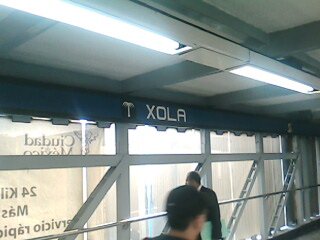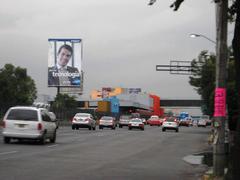Xola Mexico City: Visiting Hours, Tickets, and Historical Sites Guide
Date: 14/06/2025
Introduction: Xola’s History and Cultural Significance
Located in the southern reaches of Mexico City, Xola is a vibrant neighborhood that offers an authentic window into the city’s rich history and dynamic urban life. Once part of the Mexica (Aztec) city-state of Tenochtitlan, the area now known as Xola retains deep indigenous roots, notably linked to the Aztec god Xolotl and the xoloitzcuintli dog, both powerful symbols of transformation and guidance. Over centuries, Xola has evolved from pre-Hispanic agricultural land through colonial incorporation, to a lively urban area blending historical references with modern developments. Today, Xola is easily accessed via Metro Line 2 and acts as a gateway to a wealth of local cultural experiences, from public art to bustling markets and significant landmarks like the Parroquia del Señor del Buen Despacho and Xola Julio Prieto Theater (Wikipedia: History of Mexico City; American Indian Magazine: Xoloitzcuintli; MexicoCity.cdmx.gob.mx: Historical Timeline; Teatro Xola Julio Prieto).
This guide covers Xola’s historical context, practical visiting hours, ticketing details, travel tips, local food recommendations, nearby attractions such as Coyoacán and Xochimilco, and essential advice for a memorable and safe visit (CDMX Tourist Guide PDF; Nomadic Foodist: Mexico City Tips).
Table of Contents
- Introduction
- History of Xola
- Visiting Hours, Tickets, and Accessibility
- Getting to Xola & Navigating the Neighborhood
- Cultural Experiences, Food, and Nearby Attractions
- Visiting Xola Julio Prieto Theater
- Parroquia del Señor del Buen Despacho
- Practical Visitor Tips
- Frequently Asked Questions (FAQ)
- Visuals and Media Suggestions
- Conclusion and Call to Action
- References
History of Xola: From Pre-Hispanic Roots to Urban Hub
Pre-Hispanic Foundations
Xola’s territory formed the southern portion of ancient Tenochtitlan, the Mexica capital founded circa 1325 CE. The area’s fertile lakes and chinampas (floating agricultural plots) supported large populations, and its canal and causeway systems facilitated trade and communication (Wikipedia: History of Mexico City; Britannica: History of Mexico City).
Colonial and Modern Evolution
With the Spanish conquest in 1521, Tenochtitlan was razed and rebuilt as colonial Mexico City. Xola’s name is believed to derive from the Nahuatl “Xolotl,” referencing both the Aztec god of transformation and the xoloitzcuintli dog, a recurring cultural icon. Archaeological finds near the Templo Mayor reinforce these indigenous associations (American Indian Magazine: Xoloitzcuintli).
During the 19th and 20th centuries, Xola experienced significant urbanization, especially after projects like the draining of lakes and construction of major avenues (e.g., Avenida de los Insurgentes). Today, Metro Xola station connects the area efficiently to the city center (MexicoCity.cdmx.gob.mx: Historical Timeline).
Cultural Identity
Xola reflects Mexico City’s multilayered identity, with murals, festivals, and public art celebrating its indigenous and modern heritage. The neighborhood is part of Benito Juárez borough and borders historic districts such as Coyoacán (CDMX Tourist Guide PDF).
Visiting Hours, Tickets, and Accessibility
Neighborhood Access
Xola is a residential and transit area open to all; no tickets or specific visiting hours are required. Public spaces, markets, and street art can be explored during daylight hours. For nearby museums or theaters, check official websites for operating hours.
Guided Tours & Events
Some walking tours and cultural experiences include Xola, focusing on its history, art, and cuisine. Seasonal festivals and public events enrich the local experience.
Accessibility
Xola Metro station and most public areas are wheelchair accessible, with ramps and elevators at transit points. Some older sidewalks may be uneven; for specific needs, consult local resources.
Getting to Xola & Navigating the Area
- Metro: Xola station (Line 2, Blue Line) offers the most direct and affordable access, with rides at 5 MXN (2025). Avoid rush hours for comfort (Nomadic Foodist: Mexico City Tips).
- Taxi/Rideshare: Uber and authorized taxis are safe and convenient.
- Walking: The neighborhood is pedestrian-friendly for exploring shops, parks, and eateries.
Safety
Xola and Benito Juárez are safe by day; use standard precautions and opt for official transport after dark (Anna Everywhere: Mexico City Travel Tips).
Cultural Experiences, Food, and Nearby Attractions
Culinary Delights
Sample authentic street food, including tacos, tamales, quesadillas, and sopes at Mercado de Portales and other local markets (CDMX Tourist Guide PDF).
Nearby Attractions
- Historic Center: Access via Metro Line 2 for the Zócalo and Templo Mayor Museum.
- Coyoacán: Famous for the Frida Kahlo Museum and colonial plazas.
- Xochimilco: Enjoy colorful trajineras on UNESCO-listed canals.
Visiting Xola Julio Prieto Theater
A key cultural landmark, the Xola Julio Prieto Theater has anchored Mexico City’s performing arts for over half a century.
- Visiting Hours: Typically 3:00 PM–10:00 PM on event days.
- Tickets: MXN 100–300, available online or at the box office.
- Accessibility: Wheelchair-friendly with designated seating.
- Guided Tours: Offered occasionally; inquire in advance.
Attending a show provides a unique window into Mexican theatrical and musical culture.
Parroquia del Señor del Buen Despacho
Located in Del Valle, this mid-20th-century church is both a spiritual and architectural highlight.
- Opening Hours: Mon–Sat, 8:00 AM–7:00 PM; Sun, 7:00 AM–8:00 PM.
- Admission: Free (donations welcome).
- Guided Tours: Weekends at 10:00 AM and 4:00 PM; advance booking advised.
The church blends modernist architecture with traditional motifs and serves as a hub for local festivals, especially during the Day of the Dead.
Nearby Sites:
- Parque de las Arboledas (relaxation)
- Mercado Tlacoquemécatl (artisanal goods)
- Avenida Insurgentes Sur (dining, shopping, and more cultural venues)
Practical Visitor Tips
Safety & Health
- Use common urban precautions.
- Stick to well-populated, well-lit routes after dark.
- Drink bottled or filtered water.
- Use sunscreen and stay hydrated (city altitude is 2,240 m).
Money & Payments
- Use ATMs in banks/malls.
- Carry some cash for small markets.
- Tips: 10–15% in restaurants.
Language & Connectivity
- Spanish is primary; translation apps help.
- Free Wi-Fi in many public spaces; local SIMs are affordable.
Accessibility
- Metro and major venues are accessible; sidewalk conditions may vary.
Essential Apps
- Metro CDMX, Uber/Didi, Google Maps, Locatel for emergencies.
Responsible Tourism
- Support local businesses, dispose of trash properly, and respect customs.
Frequently Asked Questions (FAQ)
How do I reach Xola?
Via Metro Line 2 (Xola station), Uber, or authorized taxi.
Are there entrance fees?
No; metro fare is MXN 5. Attractions like theaters have separate fees.
Is Xola safe?
Yes, during the day; follow standard precautions.
Are guided tours available?
Yes, especially for cultural and culinary topics.
Best time to visit?
Daytime, especially mornings or early afternoons.
Visuals and Media Suggestions
Enhance your visit with images of Xola’s murals, the Julio Prieto Theater, Parroquia del Señor del Buen Despacho, and vibrant markets. Maps showing Xola’s location and key routes are helpful.
Suggested alt tags: “Xola Julio Prieto Theater facade,” “Traditional market in Xola Mexico City,” “Street view of Avenida Xola,” “Parroquia del Señor del Buen Despacho exterior.”
Conclusion and Call to Action
Xola offers a fascinating journey through Mexico City’s historical tapestry—from Aztec heritage through colonial transformation to contemporary vibrancy. Well-connected and culturally rich, Xola is perfect for those seeking authentic local experiences, dynamic festivals, and a taste of the city’s artistic spirit.
Plan your visit today:
Download the Audiala app for personalized travel tips, offline maps, and exclusive guided tours. Explore our related articles on Mexico City’s best cultural sites, and follow us on social media for real-time updates and insider advice!
References
- Wikipedia: History of Mexico City
- American Indian Magazine: Xoloitzcuintli
- MexicoCity.cdmx.gob.mx: Historical Timeline
- Teatro Xola Julio Prieto
- CDMX Tourist Guide PDF
- Nomadic Foodist: Mexico City Tips
- Anna Everywhere: Mexico City Travel Tips
- Time Out Mexico City
- Lonely Planet: Best Neighborhoods in Mexico City
- TripSavvy: Mexico City Neighborhoods Guide
- Let’s Travel to Mexico: Mexico City in June
- Culture Straveled: Where to Stay in Mexico City
- Official Mexico City Tourism












































































































































































